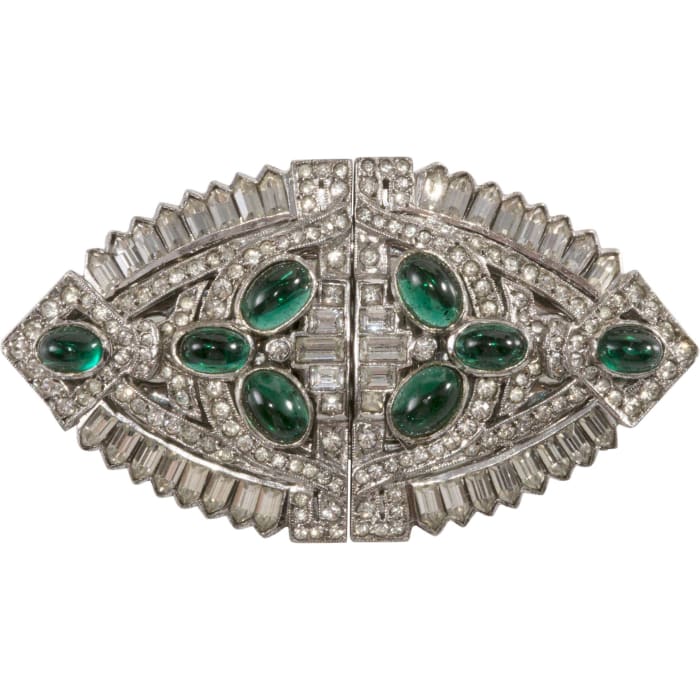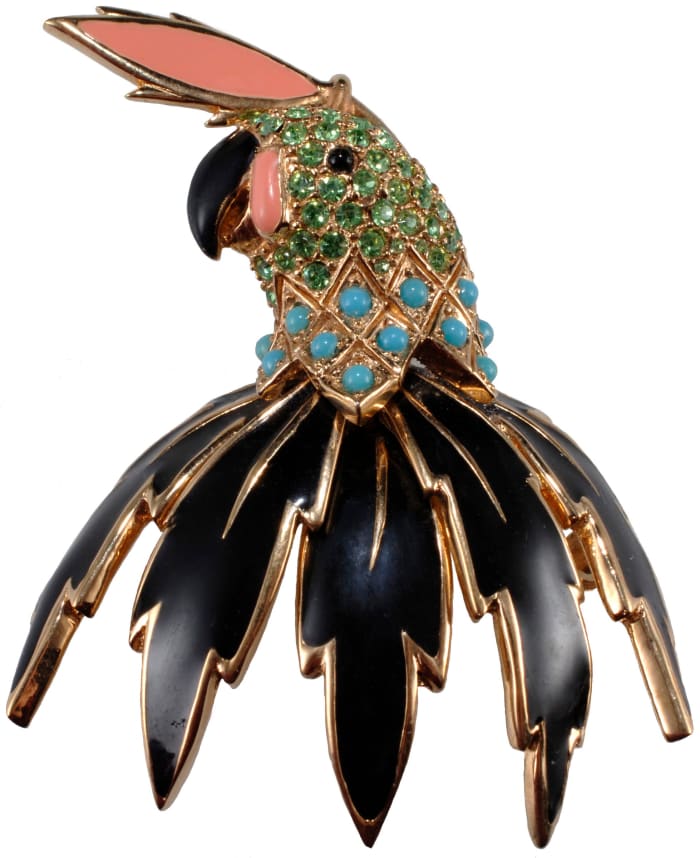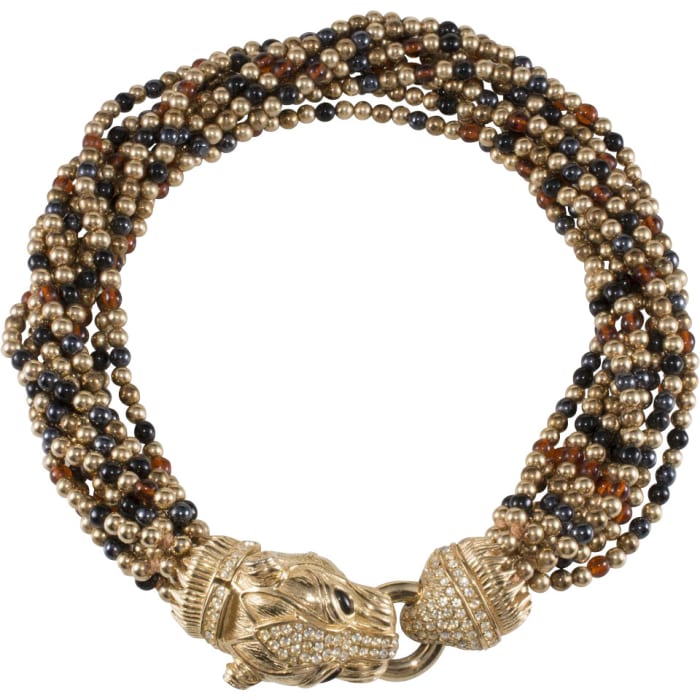The first time I visited Ciner’s New York showroom in 2011, I was bowled over by the array of jewelry on display. As I opened drawer after drawer of samples, I recognized vintage styles that had been offered to their clients for literally decades.
As a jewelry collector, I was completely in awe. When Costume Jewelry Collector’s Int’l (CJCI) had the opportunity to honor Ciner at our 2017 convention, I was knocked off my feet yet again.
Pat Ciner Hill and her daughter Jean graciously accepted the 2017 CJCI Achievement Award – a recognition reserved for costume jewelry-related businesses and designers still manufacturing in the United States – on behalf of their company during our event. They also very generously gifted a specially marked Ciner bee pin, one of their classic designs, to each of our attendees in celebration of the company’s 125th year in business.
It’s my extreme pleasure to share more on the history, identification, and dating of jewelry made by this celebrated manufacturer through this month’s “All That Glitters” column.
Ciner: In the Beginning
The company’s founder, Emmanuel Ciner, got his start as a fine jeweler in 1892. Charles and Irwin Ciner, his sons, began apprenticing in the family business in 1922. Emmanuel Ciner continued working with his sons until he died in 1958 at the age of 92.
During the Great Depression, like many other fine jewelers of the day, the Ciners ventured into costume jewelry manufacture to keep customers that could no longer afford fine jewelry happy with nicely crafted imitations. With an eye for quality, the company began by producing sterling silver pieces set with glass cabochons, high-quality rhinestones, and other stones such as marcasite. Many of the designs rivaled fine jewelry pieces, and the craftsmanship of these early styles is impeccable. They’re also fairly hard to come by today.
As time passed, Ciner added jewelry made of plated base metals to their lines. They also perfected the use of rubber molds for casting during the 1930s and manufactured armaments for the United States government during World War II. This work kept the company alive until they could resume making complete lines of jewelry in the late ’40s. Even after war restrictions lifted, Ciner continued to make limited edition jewelry using sterling silver settings.
It was also during the late 1940s that Jolie Gabor, the mother of Zsa Zsa and Eva Gabor, began carrying Ciner jewelry in her Madison Avenue boutique in New York. This was just one of the numerous shops that sold Ciner around the United States. In the decades to follow, more and more department stores began to offer Ciner jewelry to their clientele. Among the elite customers who owned and wore this jewelry were actress Elizabeth Taylor and Spain’s Queen Sofia.
In 1979, Pat Ciner Hill, who is the daughter of Irwin Ciner and granddaughter of Emanuel Ciner, took the reins of the company. Her husband David Hill, who sometimes designed jewelry for the firm, assisted her with operations through 2008 when he passed away. Along with producing some of the classic styles the company first introduced during the 1950s and ’60s, the 1980s saw Ciner embrace the call for bold costume jewelry. From torsade necklaces to animal bangles, Ciner’s jewelry sold very well during this decade.
Jean Hill joined her parents in the family business in 1984 and still helps her mother run the company today. Ciner continues to produce costume jewelry lines in their New York factory with the same attention to detail found in their vintage pieces. They supply jewelry to the Metropolitan Museum of Art in New York through a time-honored partnership and collaborate with smaller boutiques to make custom lines along with serving larger retailers through their showroom.

Ciner sterling silver ‘duette brooch’ (separates into two dress clips), 1930s.
Image courtesy Jay B. Siegel
Identifying and Dating Ciner Jewelry
The vast majority of costume jewelry pieces made by Ciner were indeed signed. That means if you find a vintage item that kind of looks like Ciner, but you can’t find a mark, it’s probably a piece known as a “period copy.” Some of them even have back texturing similar to the small circles Ciner used on some of their pieces. Upon close inspection, however, the quality is usually inferior to marked items.
And since the company used some of the same marks during different time periods, it is almost impossible to use them for dating purposes. To further complicate the process, the company continued to make some of their most popular designs over many decades. This makes the dating task one of the most difficult aspects of collecting Ciner, but it can be accomplished.
Since the first Ciner costume jewelry made during the 1930s was cast in sterling silver, that’s a big clue. If you run across a high-quality silver piece with an older look to it, say an Art Deco duette-style brooch or a piece set with marcasites, then you can fairly accurately date it. Keep in mind, however, that Ciner did sparingly use sterling silver later so looking for style cues is vital.
When dating the classic designs from the ’50s and ’60s, it usually comes down to looking for signs of wear and patina that only occur with age. For instance, Moghul styles like wide bracelets and colorful brooches decorated with jewel-toned cabochons made during the 1960s will have more of a matte, aged look to the gold plating. Newer versions made later, especially brooch styles revived during the ’80s, ’90s, and 2000s, have brighter gold plating.
Ciner also made many colorful and creative pieces in the 1980s that were on trend at the time. Learning about styles that were popular during this decade helps to pin down dating. This includes torsade necklaces with clasps that coordinate with a bevy of jeweled and enameled animal head bracelets. Many pairs of earrings were made in bold styles with large, colorful rhinestones and cabochons as well. All these items sold well and were widely copied by other manufacturers. Current production from this company includes some amazing collaborations with designers and boutiques to create new lines. And, of course, they’re still making a number of those aforementioned classics that have been a staple of the business for decades. A visit to CinerNY.com is a great place to learn more about the firm’s heritage and to see what’s new all in one trip.
YOU MAY ALSO LIKE












